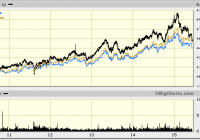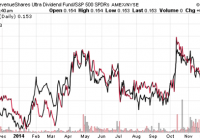Why You Should Own Utility Westar Energy
As regulated assets increase with reduced debt and equity needs, the incremental earnings should improve overall ROIC. With the decline in share price since peaking in January, Westar offers an acceptable yield and low payout ratio of around 64%. Kansas has a neutral regulatory environment, but growth is pegged to FERC-regulated transmission assets. Westar Energy (NYSE: WR ) is a mid-sized regulated electric utility in the heart of the Midwest. The company service 700,000 electric customers in central and northeast Kansas. WR also has a relatively high 6,200 miles of transmission lines and seven power plants with generating capacity of 7,160MW. There is a lot to like about WR from a longer-view perspective. Over the past 5 years, stock price performance has kept up with the Dow Jones Utility Index (DJU) and outperformed the S&P Utility Index (NYSEARCA: XLU ). However, over the last 6 months, WR has performed worse than these indexes by losing around 12% vs. 5% for the overall peer index. Morningstar reports 1-yr total return at -1.0% vs. its regulated electric utility peers at 3.1%, 3-yr total return at 9.3% vs. 11.3% respectively, 5-yr return of 14.1% vs. 11.3% respectively, and 10-yr total return at 7.6% vs. 8.3% respectively. Below are 5-yr and 6-month price only charts: 5-yr 6-month Westar’s Equity Quality rating by S&P Capital IQ for 10-yr consistency in earnings and dividend growth is A-. This falls within the top 25% of all publicly traded utilities with 10 firms rated A+ or A, and 15 firms rated A-. WR has an average credit rating at BBB+. Westar has been investing in its regulated asset base for the past several years. While WR has one of the largest capital expansion programs of a utility its size, free cash flow has remained almost neutral over the previous 2 ½ years. Previous expansion of WR regulated assets is driving the current growth in operating cash flow. For example, in 2011 and 2012, WR invested a combined $1.5 billion but had operating cash flow of just a bit over $1.0 billion, generating a free cash flow deficit of $500 million. However, in 2013 and 2014 combined, WR invested $1.6 billion and its operating cash flow increased to $1.5 billion, reducing the free cash flow deficit to $100 million. Over the trailing 12 months, WR has invested $821 million while generating operating cash flow of $800 million, for a deficit of only $21 million. Morningstar’s analysis of this asset driven aspect for Westar: Between 2006 and 2013, Westar increased its asset base from $5.5 billion to $9.6 billion, and we expect that it could top $11 billion by 2017. Its equity base has doubled since 2007 with its investments in new power plants, environmental upgrades, wind farms, and large transmission lines. With cash flow tight, investors have had to settle for pedestrian 3% annual dividend growth. But as Westar’s investment pace slows and rate increases flow in, dividend growth should accelerate. In addition, as Westar’s investment mix shifts to higher-return transmission projects, earned returns and cash flow should grow. Westar is waiting on a decision on a rate case that could increase rates by an average of 7.0% to 7.9%, and would represent the first rate increase since 2012. Included in the rate request will be approval of $600 million in upgrades to coal plants for environmental investments and to its nuclear plant to expend its useful life. While the company is requesting a $152 million rate increase, it is likely the PUC will approve around $135 million. In dealing with the issue of distributed generation, WR’s rate request include higher fixed charges with the monthly fee increasing for $12 to $15 in year one and to $27 by year four. If approved, the rate plans would shift a greater percentage of Westar’s revenues to fixed monthly fees, which better reflects the utility’s cost to serve its customers. Kansas is considered by S&P Credit to be a neutral regulatory environment. The anticipated allowed ROE for its state-regulated assets will be set at 10.0% with the resolution of the pending rate case. About 18% of WRs asset base are federally regulated transmission assets with a higher allowed ROE of 11.3%, and some projects in central Kansas carry an allowed ROE of 12.3%. However, the Kansas utility commission has filed an appeal to the FERC to reduce transmission ROE to just below 10%. Westar has a growing transmission profile as transmission investments will be about a third of the firm’s total cap ex budget. Currently, transco assets account of about 18% of its total regulated rate base at $1.1 billion. The company is expected to almost double the transco base over the next four years by investing $225 million a year in this business. Westar’s service area is smack in the middle of the wind-generating corridor of the Midwest with an abundance of project to connect wind farms with several grid operators to the north and south. Westar is well-versed in the transmission business and has a joint venture with American Electric Power (NYSE: AEP ) and MidAmerican Utility. On a per mile valuation comparable to ITC Holdings, the major independent publicly traded transco, Westar’s current network could be worth about $2.5 billion, or about $20 a share. With a target growth in base assets of 18% to 20% annually, not only is the regulated transmission business more profitable, but also is gaining sufficient critical mass to be considered an independent company. With the industry on the cusp of financial engineering for transmission assets, Westar is well positioned. Westar operates in a stable economic environment as described in their fourth qtr. conference call: Turning to the Kansas economy, it continues to hum along. Year-end unemployment was just over 4%, a level not seen since 2008. And it remains 150 basis points favorable to the nation. Small business formation continues at a good pace with most of that right in our service territory. Recent articles have touted our part of the world. Topeka was recently ranked America’s top ten most affordable cities by livability.com and a new report by the Brookings Institute ranked Wichita, which is our largest city that we serve, third in the nation among top 100 metro areas for concentration of jobs in advanced industries. These instances and a state report showing a 6% increase last year in the number of new businesses registered validate our outlook for our Kansas economy that has a lot of offer. Westar has historically generated above average return on invested capital ROIC. In an industry where the average ROIC is between 4% and 5%, since 2004, WR has consistently generated ROIC in the 5.5% to 6.0% level. Below is a 20-yr ROIC chart courtesy of fastgraph.com. (click to enlarge) With a weighted cost of capital of 5.2%, as calculated by ThatsWACC.com, management has barely generated sufficient returns over its cost of capital. On the brighter side, there are utilities that generate negative Net ROIC. However, as regulated assets increase with reduced debt and equity requirements, the incremental earnings should improve overall ROIC. Westar is trading at a slight discount to its peers with a forward P/E of 13.7. Below is a table from morningstar.com reflecting higher operating statistics such as 3-yr revenue and net income growth and operating margins compared to industry averages. However, these attributes is not reflected in the share price. Source: morningstar.com Fastgraph.com historic graph suggests WR is fairly valued. At the end of 2014, the yield was 3.4%, but has improved to a more historic year-end average of 4.1% yield (the downside to the yield improvement was a decline in price). Dividend growth has been a bit shy of many in the utility sector but could ramp up as earnings continue to grow at 6% a year. With the financial troubles of the early 2000s, an annual increase in the dividend goes back only 10 years, a bit light for a utility with Westar’s roots. The low payout ratio of 64% allows management to increase the dividend faster than its underlying earnings growth without jeopardizing its financials. (click to enlarge) The June investor’s presentation is one of the most through descriptions of various aspects of their business. Even current shareholders should learn something new by reviewing the information and it is recommended reading. However, Westar has a bit of a tarnished history . In 2002, then-CEO David Wittig and his Chief Strategic Officer were fired for alleged financial improprieties and the company, then known as Western Resources, almost went bankrupt. Wittig was convicted in federal court of 39 counts of financial malfeasance in 2005, but it was over turned in 2007. Amazingly, Wittig settled with Westar in 2011 to the tune of $42 million in compensation and legal fees from an unjust termination dispute while his underling negotiated a $22 million deal. In recap, Westar offers acceptable historic returns based on its peers, high quality ratings, rising operating cash flow to fund aggressive regulated asset accumulation, pending rate relief, good regulatory environment, growing regulated transmission asset base, increasing economic environment, stable ROIC and positive Net ROIC with the potential for increasing returns. With a typical current utility yield, the potential for above-average dividend growth is also attractive. What’s not to like about that? Author’s Note: Please review disclosure in Author’s profile. Disclosure: The author is long AEP. (More…) The author wrote this article themselves, and it expresses their own opinions. The author is not receiving compensation for it (other than from Seeking Alpha). The author has no business relationship with any company whose stock is mentioned in this article.


